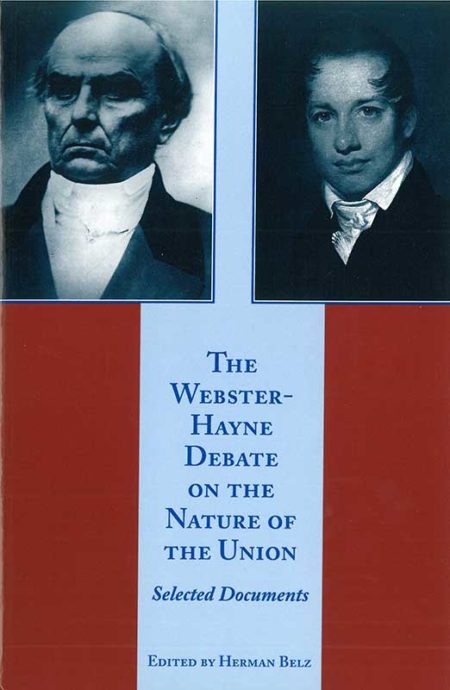Competing Conceptions of Union and Ordered Liberty in The Webster-Hayne Debate
Herman Belz’s The Webster-Hayne Debate on the Nature of the Union is the first document collection included in Liberty Fund’s series of Liberty Classics. This is a fitting acknowledgment of the debate’s importance in American history. Although once well-known, modern Americans have all but forgotten these debates and their underlying principles. This neglect reflects both the failure of historical education and the near-total victory of Daniel Webster’s nationalist narrative. So ingrained has been this nationalist triumph that, for most Americans today, the real dispute is not whether the federal government has supreme authority but how it should use that power. Despite this dominance, issues such as the decriminalization of marijuana, the Tenth Amendment resolutions passed by state legislatures in recent years, and the tug-of-war between states and the federal government over education demonstrate that the long-neglected ideas espoused by Robert Y. Hayne remain relevant to diagnosing where the American experiment in self-government went wrong.
With Belz, Liberty Fund could not have picked a better editor. A prolific constitutional scholar, including co-authorship of what is still the standard textbook in American constitutional history, Belz spent his career explaining and defending the ideas of ordered liberty. With the Webster-Hayne Debate, Belz brings his formidable knowledge to bear in his brief, informative introductory essay. Belz points out that while Webster and Hayne were the obvious antagonists in the debates, they were not the only participants. Beginning in January of 1830, twenty-one of the then forty-eight members of the Senate spoke on this issue and delivered a total of sixty-five speeches among them. Nor was this debate a scripted, timed, and oft-boring spectacle like those common in today’s Senate. Like the rolling snowball that creates an avalanche, the debates began over the seemingly innocuous question of what to do with western land sales and then morphed into an examination over the nature of the American union. Occurring over a three-month period, the debates addressed nearly every major political issue of the day including federal and state relations, the nature of judicial and executive power, the political wrangling and jockeying over the implications of the American system, the recent election of Andrew Jackson, the nullification controversy, and the growing sectional divide between North and South. The speeches Belz included in this volume all feature these topics.
While Belz’s collection contains speeches by other participants, the real highlight is the clash between Webster and Hayne. Center stage in their contest were two opposing narratives on the nature of American federalism and sovereignty. As Belz notes in the introduction, the Webster-Hayne confrontation was not the first time these questions arose in American politics or constitutionalism. They were the perennial questions of the American order. Belz is right to suggest that, despite the insistence of scholars ever since the late nineteenth century, the Webster-Hayne debates were not the first steps towards civil war, but instead were yet another, albeit rather important, contribution to an argument as old as the founding.
Hayne’s Defense of Jeffersonian Constitutionalism
The first narrative, that defended by Hayne, argued for a decentralized system in which sovereignty rested with the states. To Hayne, the union and Constitution emerged from a compact of the states. As a creature of the states, the Constitution served only to regulate and normalize relations between the states. This singular purpose, Hayne noted, explained the definite and few powers of the federal government. State sovereignty, federalism, and strict constitutional limitations upon federal power, therefore, provided the order necessary for American liberty. These elements, Hayne maintained, constituted the “very life of our system.” Only the “independence of the States, and . . . by a strict adherence to the limitations imposed by the constitution on the Federal Government,” could “this system wor[k] well, and . . . answer the great ends for which it was instituted.”
The taxation and revenue schemes, such as those supported by Webster, threatened this system of ordered liberty. Such schemes “weaken[ed] the responsibility of our federal rulers to the people, and has made them, in some measure, careless of their rights, and regardless of the high trust committed to their care” and placed the union on the path to consolidation, “no evil more to be deprecated.” Placing “[t]hose partial distributions of favors, whether by legislation or appropriation, which has a direct and powerful tendency to spread corruption through the land; to create an abject spirit of dependence; to sow the seeds of dissolution; to produce jealousy among the different portions of the Union,” would “finally to sap the very foundations of the Government itself.” In other words, any attempt to grow the power of the federal government beyond its constitutional proscriptions came at the expense of the states and the liberty of the people.
Webster and Nationalist Constitutionalism
To Webster, Hayne’s remarks offered little besides fearmongering. The Massachusetts Senator’s speeches, significantly longer and more verbose than his South Carolina counterpart, attacked Hayne’s position by offering a distinctly nationalist narrative. The Constitution, he claimed, was not the compact of the states but was born from the American people. “[T]he People, then, sir, erected this Government. They gave it a Constitution, and in that Constitution they have enumerated the powers which they bestow on it.” Webster scoffed at the idea of consolidation, labeling it “that perpetual cry, both of terror and delusion.” What Hayne and his supporters actually meant to do, Webster claimed, was to resist those means that might strengthen the bonds of common interest. They may consider the union as “a possible means of good; or on the other hand, as a possible means of evil. They cherish no deep and fixed regard for it, flowing from a thorough conviction of its absolute and vital necessity to our welfare.” Webster, instead, “rejoice[d] in whatever tends to strengthen the bond that unites us, and encourages the hope that our Union may be perpetual.” This need to strengthen the bonds of the union, Webster, maintained was “true constitutional consolidation.”
Thus, when stripped of its rhetoric, the essence of the debates focused on whether the union served as a means or as an end. For Hayne and his supporters, liberty was the end; it existed within the separate sovereign states and persisted whether or not the union endured. A union of the states, which the Constitution and its enumerated powers represented, however, provided means to help perfect that liberty. This belief was antithetical to that of Webster. For him, liberty could not exist without union. In the most famous passage from the debates, and the one school children were once forced to memorize, Webster noted
Nor those other words of delusion and folly, Liberty first, and Union afterwards—but everywhere, spread all over in characters of living light, blazing on all its ample folds, as they float over the sea and over the land, and in every wind under the whole Heavens, that other sentiment, dear to every true American heart—Liberty and Union, now and forever, one and inseparable!
In other words, liberty and union were not just intertwined but symbiotic. Any effort to strengthen the means of union could be justified by the empowering ends of the Constitution.
The Broader Constitutional Context of the Webster-Hayne Debate
It is ironic that the principles Hayne defended have lapsed into irrelevancy and even derision. Hayne’s remarks were not original nor innovative; at the time, they reflected orthodox constitutionalism to the majority of Americans. Hayne pointed out to Webster and other detractors that his view of the American order as a “federal and not a national Union” had a long historical pedigree that transcended sectionalism. Although he traced this pedigree to the Anti-Federalists, Hayne could have gone further. Questions of federalism and the location of sovereignty was the constitutional question that sparked the American Revolution with state sovereignty based federalism receiving constitutional protection with Article II of the Articles of Confederation; it was a foundation of the Anti-Federalists’ resistance to the Constitution and drove their calls for a Bill of Rights; it had received acknowledgment and defense in the Tenth Amendment, the Kentucky and Virginia Resolutions, and James Madison’s Report of 1800; and was the cornerstone of Jeffersonian and Jacksonian constitutionalism. This history mattered. It breathed life and meaning into Hayne’s conception of the union. And, this Jeffersonian conception persisted long after the Webster-Hayne debate in the North, through its efforts to resist the Fugitive Slave Act of 1850, and culminated with secession in the South.
Nor was Webster’s nationalist constitutionalism new. Borrowed from the British example and forged from broad latitudinal readings of constitutional authority, Webster’s arguments for a stronger union originated with Alexander Hamilton, James Wilson, and John Marshall. Not coincidentally, heading this stronger union was a national government vested with a more robust and undivided sovereignty. But a significant, and frequently overlooked, difference existed between Webster’s nationalism and the state sovereignty position of Hayne. Despite some victories under Hamilton and Marshall, nationalist constitutionalism in 1830 remained largely theoretical. Hence, nationalists of the Revolutionary era and up to and beyond Daniel Webster had to appeal to a hoped-for future of American destiny and greatness rather than the textual support and the lived experiences that characterizes Hayne’s constitutionalism. Ultimately, when nationalist constitutionalism did win and transformed from theory to practice, that victory came via the bayonet and continues now, just as Hayne predicted, through the federal treasury and appropriations.
Belz’s collection reveals two incompatible visions of American constitutionalism and ordered liberty. If Americans today believe that their politics and constitutionalism have gone off the rails, perhaps that is due, in no small part, to our abandonment of an ordered liberty rooted in state sovereignty and the limited capabilities of the federal government. If nothing else, a return to these once-famous—and still important—debates makes this abundantly clear.

